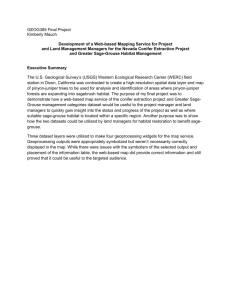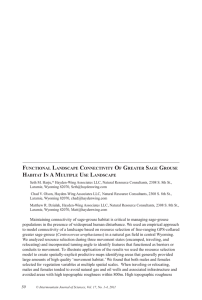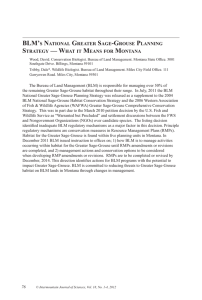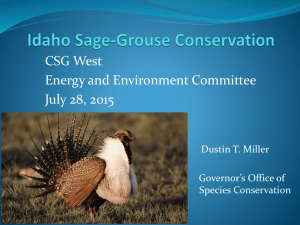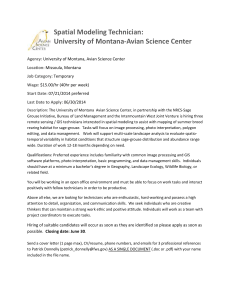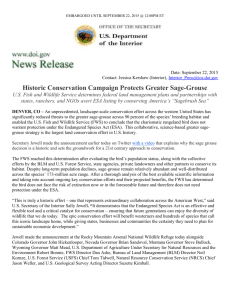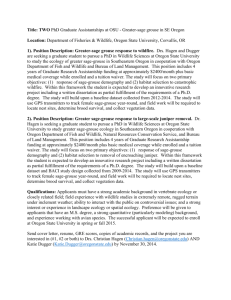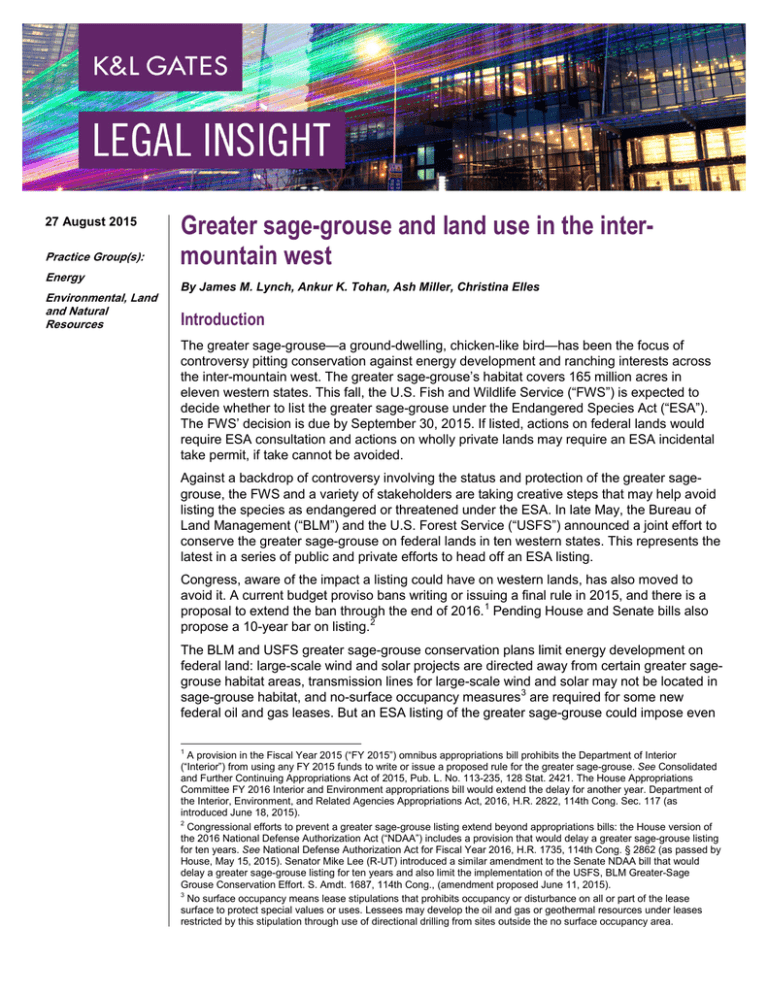
27 August 2015
Practice Group(s):
Energy
Environmental, Land
and Natural
Resources
Greater sage-grouse and land use in the intermountain west
By James M. Lynch, Ankur K. Tohan, Ash Miller, Christina Elles
Introduction
The greater sage-grouse—a ground-dwelling, chicken-like bird—has been the focus of
controversy pitting conservation against energy development and ranching interests across
the inter-mountain west. The greater sage-grouse’s habitat covers 165 million acres in
eleven western states. This fall, the U.S. Fish and Wildlife Service (“FWS”) is expected to
decide whether to list the greater sage-grouse under the Endangered Species Act (“ESA”).
The FWS’ decision is due by September 30, 2015. If listed, actions on federal lands would
require ESA consultation and actions on wholly private lands may require an ESA incidental
take permit, if take cannot be avoided.
Against a backdrop of controversy involving the status and protection of the greater sagegrouse, the FWS and a variety of stakeholders are taking creative steps that may help avoid
listing the species as endangered or threatened under the ESA. In late May, the Bureau of
Land Management (“BLM”) and the U.S. Forest Service (“USFS”) announced a joint effort to
conserve the greater sage-grouse on federal lands in ten western states. This represents the
latest in a series of public and private efforts to head off an ESA listing.
Congress, aware of the impact a listing could have on western lands, has also moved to
avoid it. A current budget proviso bans writing or issuing a final rule in 2015, and there is a
proposal to extend the ban through the end of 2016. 1 Pending House and Senate bills also
propose a 10-year bar on listing.2
The BLM and USFS greater sage-grouse conservation plans limit energy development on
federal land: large-scale wind and solar projects are directed away from certain greater sagegrouse habitat areas, transmission lines for large-scale wind and solar may not be located in
sage-grouse habitat, and no-surface occupancy measures 3 are required for some new
federal oil and gas leases. But an ESA listing of the greater sage-grouse could impose even
1
A provision in the Fiscal Year 2015 (“FY 2015”) omnibus appropriations bill prohibits the Department of Interior
(“Interior”) from using any FY 2015 funds to write or issue a proposed rule for the greater sage-grouse. See Consolidated
and Further Continuing Appropriations Act of 2015, Pub. L. No. 113-235, 128 Stat. 2421. The House Appropriations
Committee FY 2016 Interior and Environment appropriations bill would extend the delay for another year. Department of
the Interior, Environment, and Related Agencies Appropriations Act, 2016, H.R. 2822, 114th Cong. Sec. 117 (as
introduced June 18, 2015).
2
Congressional efforts to prevent a greater sage-grouse listing extend beyond appropriations bills: the House version of
the 2016 National Defense Authorization Act (“NDAA”) includes a provision that would delay a greater sage-grouse listing
for ten years. See National Defense Authorization Act for Fiscal Year 2016, H.R. 1735, 114th Cong. § 2862 (as passed by
House, May 15, 2015). Senator Mike Lee (R-UT) introduced a similar amendment to the Senate NDAA bill that would
delay a greater sage-grouse listing for ten years and also limit the implementation of the USFS, BLM Greater-Sage
Grouse Conservation Effort. S. Amdt. 1687, 114th Cong., (amendment proposed June 11, 2015).
3
No surface occupancy means lease stipulations that prohibits occupancy or disturbance on all or part of the lease
surface to protect special values or uses. Lessees may develop the oil and gas or geothermal resources under leases
restricted by this stipulation through use of directional drilling from sites outside the no surface occupancy area.
Greater sage-grouse and land use in the inter-mountain west
more significant restrictions that may impact land use on 165 million acres of private, state
and federal lands. The BLM, USFS plans could help prevent an ESA listing and keep the
inter-mountain west open to responsible development.
The Saga of the Greater Sage-Grouse and the ESA
The greater sage-grouse has been the subject of ESA debate and litigation for 15 years. Its
population, once estimated to be in the millions, now hovers around 200,000 to 500,000. Its
habitat covers 165 million acres across eleven western states, a loss of 56 percent from its
historic range. Of the 165 million-acre range, 64 percent is located on federal land, 31
percent on private land, and 5 percent on state land. Wyoming has the largest population
with 37 percent of the total. Montana has 18 percent, Nevada and Idaho both have 14
percent, and the remaining states each have less than 7 percent. 4
Map source: http://www.fws.gov/greatersagegrouse/maps/20140815_GRSG_Range.jpg
In 2010, the FWS determined that listing the greater sage-grouse under the ESA was
warranted, but precluded by other higher priority species. 5 Factors supporting listing included
the continued fragmentation and degradation of the greater sage-grouse habitat, and
inadequate existing local, state, and federal regulations. Specific habitat threats included
agriculture, urbanization, infrastructure (such as roads and power lines), wildfires, invasive
plants, grazing, climate change, and energy development. The FWS concluded that the
existing local, state, and federal regulatory mechanisms were inadequate to protect the
species and that in particular existing regulatory mechanisms on BLM and USFS lands were
4
See U.S. Fish and Wildlife Serv., The Greater Sage-Grouse: Facts, Figures, and Discussion (last visited June 26, 2015)
http://www.fws.gov/greatersagegrouse/factsheets/GreaterSageGrouseCanon_FINAL.pdf.
5
Endangered and Threatened Wildlife and Plants; 12-month Findings for Petitions to List the Greater Sage-Grouse
(Centrocercus urophasianus), 75 Fed. Reg. 13910-14014. To determine whether a species is endangered or threatened,
the FWS considers five factors. See 16 U.S.C. § 1533(a)(1)(A-E).
2
Greater sage-grouse and land use in the inter-mountain west
insufficient. 6 Since 64 percent of greater sage-grouse habitat is on federal lands, the lack of
regulatory mechanisms there posed a significant threat.
Environmental groups sued FWS for the 2010 “warranted but precluded” listing
determination. In 2011, the FWS reached a sweeping settlement with environmental groups
requiring the agency to issue listing decisions for hundreds of candidate species on a
specific timeline. In particular, the FWS must issue a listing decision for the greater sagegrouse, including any Distinct Population Segments (“DPS”), 7 by September 30, 2015. 8
Despite the provision in the FY 2015 omnibus appropriations bill barring Interior from using
any funds to issue or write a greater sage-grouse ESA rulemaking, FWS does not believe
that the rider has any effect “on ongoing efforts to develop and implement federal and state
plans that conserve sagebrush habitat or to completing the requisite analysis for potential
rulemaking.” 9 Thus, the agency is still expected to reach a decision by the September 30
deadline.
In April 2015, the FWS recently withdrew its proposed rule to list the Bi-State (applicable to
Nevada and California) DPS of the greater sage-grouse as threatened, 10 citing successful
conservation efforts and the implementation of the Bi-State Action Plan. This could signal
that FWS will issue a “not warranted” determination of the greater sage-grouse this fall. The
Bi-State Action plan is a collaborative conservation plan developed between federal, state,
and local agencies and landowners in Nevada and California with $45 million in funding to
implement conservation efforts over the next ten years. 11 Interior Secretary Sally Jewell
recently told the Western Governor’s Association that the withdrawal of the proposed rule for
the Bi-State sage grouse indicates that a “not-warranted listing is a clear possibility” for the
greater sage-grouse if states and the federal government continue to work together. 12
The Implications of a Greater Sage-Grouse Listing Under the ESA
Given that the greater sage-grouse’s habitat spans 165 acres in 11 states, an ESA listing
could have a significant impact on land uses in the west. Section 9 of the ESA protects listed
species from a “take” (e.g., action that would harass, harm, capture, or kill). 13 Listing the bird
as endangered would mean that no one could “take” a greater sage-grouse on public or
6
Id. at 13982.
“Distinct Population Segment” (“DPS”) is the smallest subset of a species that can be listed under the ESA. DPSs are
limited to vertebrates. See 15 U.S.C. § 1532(16).
8
Mining and ranching interests in Nevada filed suit in late 2014 challenging the validity of the 2011 Settlement Agreement,
specifically alleging that the September 30, 2015 greater sage-grouse deadline violates the ESA, the Administrative
Procedure Act, and the U.S. Constitution. The case has now been transferred to the U.S. District Court for the District of
Columbia. See F.I.M. et al. v. U.S. Department of the Interior, No. 1:15-cv-00897-EGS (D.D.C. filed June 9, 2015).
9
Press Statement, U.S. Fish and Wildlife Serv., Statement by Interior Secretary Sally Jewell on the Sage-Grouse Rider in
the FY15 Omnibus Bill (Dec. 17, 2015), http://www.fws.gov/news/ShowNews.cfm?ID=59D5150F-A05D-A1AD9E69AE3066E2183E.
10
Withdrawal of the Proposed Rule To List the Bi-State Distinct Population Segment of Greater Sage-Grouse and
Designate Critical Habitat, 80 Fed. Reg. 22827 (Apr. 23, 2015).
11
See Press Release, U.S. Fish and Wildlife Serv., Successful Conservation Partnership Keeps Bi-State Sage-Grouse Off
Endangered Species List (April 21, 2015), http://www.fws.gov/news/ShowNews.cfm?ID=DD5B828A-EFD6-2D90B779A121E74DD059.
12
Jeff DeLong, Sage Grouse Could Evade Endangered Status, Reno Gazette-Journal (June 24, 2015),
http://www.rgj.com/story/news/2015/06/24/sage-grouse-evade-endangered-status/29246867/.
13
16 U.S.C. § 1538.
7
3
Greater sage-grouse and land use in the inter-mountain west
private land unless they first secure an incidental take permit, which is a time-consuming and
expensive process.14
If the species is listed as threatened, FWS may issue regulations “necessary and advisable
to provide for the conservation of such species.” 15 A listing as threatened can be
accompanied by a 4(d) rule, which can relax ESA restrictions to minimize conflicts between
threatened species and people. For instance, the FWS recently listed the northern longeared bat as threatened and issued an interim 4(d) rule that exempted certain land use
activities from the incidental take prohibition.16 If the greater sage-grouse is listed as
threatened, the FWS could exempt specific activities from take prohibitions, such as wind
energy production and oil/gas drilling.
The BLM, USFS Greater Sage-Grouse Conservation Effort
In an effort to demonstrate that a listing of the greater sage-grouse is not warranted, the BLM
and USFS recently released a series of revised land-use plans to conserve the greater sagegrouse on federal lands in ten western states (CA, CO, ID, MT, NV, ND, OR, SD, UT, WY). 17
BLM officials call the conservation effort “the single largest public land planning effort in
United States history.” 18
Nearly two-thirds of the greater sage-grouse’s habitat is on federal lands, so the BLM, USFS
greater sage-grouse conservation strategy is essential to the survival of the species and
could help prevent an ESA listing this fall. The land use plans are a direct response to the
2010 FWS conclusion that existing regulatory mechanisms on BLM and USFS land were
inadequate to protect the greater sage-grouse.19 In addition, the BLM, USFS effort signals to
the FWS that, unlike in 2010, adequate regulations are now in place on federal land to
preserve the greater sage-grouse and that listing the species as endangered or threatened
under the ESA may not be warranted.
In the Final Environmental Impact Statements (“FEIS”) for the land-use plans (the “plans”),
the agencies selected an approach that sought to balance competing human needs and
interests with the protection, restoration, and enhancement of the greater sage-grouse
habitat. BLM and USFS worked closely with FWS, the United States Department of
Agriculture (“USDA”) Natural Resources Conservation Service (“NRCS”), western states,
and other stakeholders for more than two years to develop these plans. The plans will be
14
16 U.S.C. § 1539.
16 U.S.C. § 1533(d).
16
See Barry M. Hartman, et. al., Bats in the Balance: Northern Long-Eared Bat Listing and Interim 4(d) Rule, K&L Gates
(May 6, 2015), http://www.klgates.com/bats-in-the-balance-northern-long-eared-bat-listing-and-interim-4d-rule-05-062015/.
17
The BLM, USFS land use plans and FEIS’ are available at http://www.blm.gov/wo/st/en/prog/more/sagegrouse.html
(last visited June 25, 2015). Washington was not included since Washington’s greater sage-grouse population is
predominantly located on private land.
18
Marianne Lavelle, Sage grouse war tests limits of partnership in West, Science Magazine News (June 19, 2015),
http://news.sciencemag.org/plants-animals/2015/06/feature-sage-grouse-war-tests-limits-partnership-west.
19
Endangered and Threatened Wildlife and Plants; 12-month Findings for Petitions to List the Greater Sage-Grouse
(Centrocercus urophasianus), 75 Fed. Reg. 13982.8. The Federal Land Policy and Management Act and National Forest
Management Act direct BLM and the USFS to periodically update the plans, which guide all actions and approved uses
on public land.
15
4
Greater sage-grouse and land use in the inter-mountain west
finalized later this summer after a 60-day Governor’s Consistency Review and a concurrent
30-day protest period.20
The plans have three objectives: minimize surface disturbance of sage-grouse habitat,
improve habitat condition, and reduce the threat of rangeland fire to sage-grouse and
sagebrush habitat. 21 To achieve those objectives, the plans designate three levels of sagebrush habitat, and within each habitat area various land use activities are prohibited,
restricted, or permissible. First: “General Habitat Management Areas” (“GHMAs”), which are
the most flexible and permissible habitat areas for land use activities. Second: “Priority
Habitat Management Areas” (“PHMAs”), which have the highest conservation value for
maintaining sustainable greater sage-grouse populations. Third: “Sagebrush Focal Areas”
(“SFAs”), which are a subset of PHMAs and are considered “strongholds” for the species.
They include the highest breeding population densities and existing high-quality sagebrush
habitat. Land use activities are most restricted within SFAs. 22 23
To minimize surface disturbance of greater sage-grouse habitat, the plans limit certain land
use activities and energy development. The plans impose a disturbance cap in PHMAs to
prevent further surface disturbances (e.g., roads, oil and gas wells, buildings) and to prevent
further habitat fragmentation. The plans identify minimum buffer areas around greater sagegrouse leks—sites where greater sage-grouse return every year to mate. The buffer
distances vary by greater sage-grouse population and habitat.
The plans limits wind and solar energy projects on federal land. They steer large-scale wind
and solar projects away from PHMAs, but allow such projects in GHMAs. Developers are
also required to avoid placing transmission lines of large-scale wind and solar projects in
sage-grouse habitat. If the sage-grouse habitat cannot be avoided, the plans require
mitigation measures.
The plans also limit oil, gas, and mining on public lands. The plans prioritize new leases and
development of oil, gas, and geothermal projects outside of PHMAs and GHMAs and limit
surface disturbances from new federal leases in PHMAs and SFAs. To limit surface
disturbances and protect sensitive sage-grouse habitats, states that lack an all-lands
regulatory approach to managing disturbance are required to adopt no-surface-occupancy
measures in new federal oil and gas leases in SFAs, and, with exceptions, in PHMAs. BLM
will still recognize all valid, existing oil, gas, and geothermal projects. According to BLM and
20
See 43 CFR §§ 1610.3-2(e), 1610.5-2 (2015). Protests have been filed by conservation and industry groups, and
Governor Mead of Wyoming. See, Benjamin Storrow, Industry and environmentalists share dislike for federal sage grouse
plan, Casper Star Tribune (July 6, 2015), http://trib.com/business/energy/industry-and-environmentalists-share-dislike-forfederal-sage-grouse-plan/article_f1b8c4b3-be25-5e11-ab0d-1f44e44ea7b0.html.
21
For more information on the land use plans, see Bureau of Land Management, Fact Sheet: BLM, USFS, Greater SageGrouse Conservation Effort (last visited June 25, 2016),
http://www.blm.gov/style/medialib/blm/wo/Communications_Directorate/public_affairs/sagegrouse_planning/documents.Par.93163.File.dat/BLM-USFS%20Plans%20Fact%20Sheet%20Final.pdf.
22
As to the relative size of these designated areas, GHMAs are the usually the largest habitat management area within a
planning area, PHMAs are the second-largest, and SFAs are the smallest. Within the Wyoming greater sage-grouse
planning area, for example, 4,894,900 acres were identified as PHMAs (about 30 percent of the planning area), 1,196,000
acres were identified as SFAs, and 5,951,300 acres were identified as GHMAs (37 percent of the total planning area).
Bureau of Land Management, Wyoming Greater Sage-Grouse Proposed LUP/FEIS: Executive Summary, ES-4, ES-6
(May 28, 2015), https://eplanning.blm.gov/epl-front-office/projects/lup/9153/58379/63908/05_Executive_Summary.pdf.
23
For a map of the GHMAs, PHMAs, and SFAs in Montana’s HiLine District, see Bureau of Land Management, Map 2.18
Greater Sage-Grouse & Grassland Bird Habitat Management Areas Alternative E (Preferred) (last visited July 22, 2015),
http://www.blm.gov/style/medialib/blm/mt/field_offices/malta/rmp/proposed_rmp.Par.61792.File.dat/Map2.18%20GRSG%
20Habitat%20Mgmt%20Areas%20AltE.pdf. Maps of other habitat management areas for the plans are available within the
BLM, USFS FEIS’, available at http://www.blm.gov/wo/st/en/prog/more/sagegrouse.html (last visited June 25, 2015).
5
Greater sage-grouse and land use in the inter-mountain west
USFS, 90 percent of lands with high to medium potential are located outside of PHMAs. To
minimize surface disturbances from mining, the plans ensure that the sage-grouse habitat is
considered when BLM reviews proposed coal mines or coal mine expansions. The plans
also recommend that the Secretary of the Interior use her authority to withdraw hardrock
mining from SFAs.
Map source:
http://www.blm.gov/style/medialib/blm/wo/Communications_Directorate/public_affairs/sagegrouse_planning/graphics.Par.98981.Image.-1.-1.1.gif
Private lands conservation efforts to avoid an ESA listing
While the BLM, USFS conservation effort helps to conserve the greater sage-grouse on
federal land, conservation efforts on private lands are also underway. Eighty percent of
essential summer habitat where sage grouse raise their young (i.e., in wet habitats) are
located on private lands. 24 Fortunately, many western states have already taken steps to
conserve the greater sage-grouse on private property. These efforts help ensure that
sufficient protections are in place to conserve the greater sage-grouse and could help avoid
an endangered or threatened listing this fall.
Many states have taken steps to conserve the greater sage-grouse on state and privately
owned land. For instance, in March 2015, Wyoming and FWS launched the nation’s first
24
Sage Grouse Initiative, Science to Solutions: Private Lands Vital to Conserving Wet Areas (2014),
http://www.sagegrouseinitiative.com/wp-content/uploads/2014/09/Science-to-Solutions-Conserving-Wet-Areas-FINALLOW-RES-091614.pdf .
6
Greater sage-grouse and land use in the inter-mountain west
greater sage-grouse conservation bank. The conservation bank enables development
entities to purchase credits to offset impacts to the greater sage-grouse occurring
elsewhere.25 In May 2015, Colorado Governor John Hickenlooper issued an executive order
to protect the greater sage-grouse throughout the state. The executive order contained
multiple components, such as instructing the Colorado Oil and Gas Conservation
Commission to foster mitigation and conservation efforts and creating a market-based
habitat exchange. 26 In 2014, Montana Governor Steve Bullock created the Sage Grouse
Habitat Conservation Program, which established a variety of limitations and stipulations to
conserve the species within the state. 27
Wyoming and Oregon have greater sage-grouse Candidate Conservation Agreements
(“CCAs”) and Candidate Conservation Agreement Assurances (“CCAAs”) in effect. 28 In
2013, Wyoming finalized an umbrella CCAA with FWS to establish a greater sage-grouse
conservation framework for livestock grazing and ranch management on private and state
land. 29 The umbrella CCAA encompasses more than 17 million acres of privately owned
land. As of January 2015, more than 300,000 acres are enrolled in Wyoming’s umbrella
CCAA, and nearly 50,000 acres of greater-sage grouse habitat are enrolled in CCAs. If
participating landowners create a site-specific conservation plan that is consistent with the
umbrella CCAA, the FWS will issue the landowner an Enhancement of Survival permit. The
permit is valid for twenty years. Oregon has three CCAAs throughout the state. More than 4
million acres of privately owned land now qualify for CCAAs to conserve the greater sagegrouse.30 If Congress continues to pass legislation that prohibits FWS from issuing a listing
of the greater sage-grouse, private property owners may find the time and expense of
crafting a CCAA with FWS worthwhile.
Private and non-profit entities are also taking action to conserve the greater sage-grouse and
prevent the species from being listed under the ESA. In 2010, USDA’s NRCS formed the
Sage Grouse Initiative (“SGI”) after the FWS listed the bird as a candidate species. The SGI
partnership includes ranchers; local, state, and federal agencies; non-profit groups; and
25
See Press Release, U.S. Fish and Wildlife Serv., State of Wyoming, Sweetwater River Conservancy Launch Nation’s
First Greater Sage-Grouse Conservation Bank (March 18, 2015),
http://www.fws.gov/greatersagegrouse/news_releases/20150318%20Sweetwater%20River%20Conservation%20Bank%2
0NR%20FINAL.pdf.
26
Colo. Exec. Order D 2014-004, May 15, 2015, https://www.colorado.gov/pacific/sites/default/files/atoms/files/EO-D2015-002.pdf.
27
Mont. Exec. Order No. 10-2014, Sept. 9, 2014,
https://governor.mt.gov/Portals/16/docs/2014EOs/EO_10_2014_SageGrouse.pdf.
28
CCAs and CCAAs are another way to conserve the greater sage-grouse on private property. Individual property owners
may enter into voluntary agreements with the FWS to conserve the candidate species, so that an ESA listing may not be
necessary. The FWS can enter into CCAs with states, local governments, tribes, and private property owners. CCAs
however, unlike CCAAs, do not provide any permits that authorize incidental takes or assurances should the candidate
species eventually be listed under the ESA. A CCAA provides property owners an Enhancement of Survival permit under
Section 10 of the ESA. The permit provides assurances to the property owner that if the candidate species is eventually
listed, they do not have to engage in additional conservation measures and they are entitled to a specific level of
incidental take of the covered species without penalty. CCAs and CCAAs conserve candidate species on private property
to help avoid an ESA listing and provide certainty to private property owners. States, tribes, and local governments may
create programmatic or “umbrella” CCAAs with FWS and then enroll individual property owners in a specific region. See
U.S. Fish and Wildlife Serv., Candidate Conservation (last updated June 16, 2014), http://www.fws.gov/endangered/whatwe-do/cca.html.
29
See U.S. Fish and Wildlife Serv., Greater Sage-Grouse CCAA for Wyoming Ranch Management (last visited June 26,
2015), http://www.fws.gov/wyominges/Pages/LandownerTools/CCAA/CCAA_GSG.html.
30
See Press Release, USDA, Secretary Jewell, Governor Brown, Deputy Under Secretary Mills Celebrate Landmark
Agreements to Conserve up to 2.3 Million Acres of Sagebrush Habitat in Oregon (March, 27, 2015),
http://www.usda.gov/wps/portal/usda/usdamediafb?contentid=2015/03/0077.xml&printable=true&contentidonly=true.
7
Greater sage-grouse and land use in the inter-mountain west
business. SGI focuses mostly on reducing threats to the greater sage-grouse on private
lands. Since SGI began in 2010, the organization has invested $425.5 million in greater
sage-grouse conservation efforts, working with 1,129 ranches to restore more than 4.4
million acres of the species’ habitat. 31
Conclusion
An endangered or threatened listing of the greater sage-grouse would limit land use activities
throughout 165 million acres in the western U.S. Local, state, and federal agencies, private
landowners, and nonprofits have gone to great lengths to conserve the species and avoid an
ESA listing. Those collective efforts impact land-use activities and will have long-term
implications for energy development across the inter-mountain west. It remains to be seen
whether these efforts will be enough for the FWS to issue a “not warranted” determination
this fall.
Authors:
James M. Lynch
jim.lynch@klgates.com
+1.206.370.6587
Ankur K. Tohan
ankur.tohan@klgates.com
+1.206.370.7658
Ash Miller
ashley.miller@klgates.com
+1.206.370.7962
Christina Elles
Anchorage Austin Beijing Berlin Boston Brisbane Brussels Charleston Charlotte Chicago Dallas Doha Dubai Fort Worth Frankfurt
Harrisburg Hong Kong Houston London Los Angeles Melbourne Miami Milan Moscow Newark New York Orange County Palo Alto Paris
Perth Pittsburgh Portland Raleigh Research Triangle Park San Francisco São Paulo Seattle Seoul Shanghai Singapore Spokane
Sydney Taipei Tokyo Warsaw Washington, D.C. Wilmington
K&L Gates comprises more than 2,000 lawyers globally who practice in fully integrated offices located on five
continents. The firm represents leading multinational corporations, growth and middle-market companies, capital
markets participants and entrepreneurs in every major industry group as well as public sector entities, educational
institutions, philanthropic organizations and individuals. For more information about K&L Gates or its locations,
practices and registrations, visit www.klgates.com.
This publication is for informational purposes and does not contain or convey legal advice. The information herein should not be used or relied upon in
regard to any particular facts or circumstances without first consulting a lawyer.
31
See USDA, Natural Resources Conservation Service, Outcomes in Conservation: Sage Grouse Initiative (February
2015), http://www.sagegrouseinitiative.com/wp-content/uploads/2015/02/NRCS_SGI_Report.pdf.
8
Greater sage-grouse and land use in the inter-mountain west
© 2015 K&L Gates LLP. All Rights Reserved.
9

